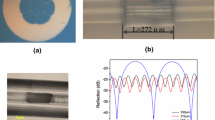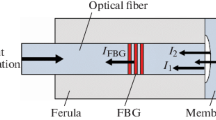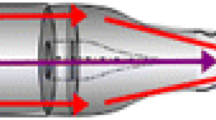Abstract
In this paper we present a novel, time-delay approach using a copper-coated fiber. Piezo optical-fiber stretchers and temperature-controlled fiber spools are normally used for a conventional time-delay lines. A copper-coated fiber preserves the performance of a standard single-mode optical fiber, while at the same time acting as an electrical wire, which can be effectively heated by applying an electrical current. As a result of the significant temperature change, the signal (group) delay can be properly adjusted and controlled. Compared to piezo optical-fiber stretchers and temperature-controlled fiber spools, much shorter lengths of fiber are required and a faster response time can be achieved. This paper also proposes a simple, lumped thermal model and thus a copper-coated fiber can be included in the heat-transfer and response-time calculations of a realistic system that involves surrounding elements (e.g., heatsinks).






Similar content being viewed by others
Notes
If the input electrical signal has a sine wave form of low frequency, the optical group delay changes with the same frequency. The frequency of the input signal where the aplitude of the optical group delay falls to one half is considered to be the bandwidth.
Time required for the temperature to rise from 10 to 90 % or to fall from 90 to 10 % of its maximum value (Levine 1996).
References
Batagelj, B., et al.: Use of femtosecond synchronization system with long-term stability over optical infrastructure. ICTON 2011, 1–4 (2011)
Bergman, T.L., et al.: Introduction to heat transfer, 78–85, 282–289. Wiley, NJ (2011)
Bousonville, M., Rausch, J.: Velocity of signal delay changes in fibre optic cables, DIPAC09, TUPB35, 248–250 (2009)
Frisch J., et al.: The RF phase distribution and timing system for the NLC, LINAC 2000, THA05, 745–747 (2000)
Hartog, A.H., et al.: Variation of pulse delay with stress and temperature in jacketed and unjacketed optical fibres. Opt. Quantum Elect. 11, 265–273 (1979)
Kothandaraman, C.P.: Fundamentals of Heat and Mass Transfers, 203–207. New Age International Pvt Ltd Publishers, New Delhi (2006)
Levine, W.S.: The control handbook, 1548. CRC Press, Boca Raton (1996)
Meade, R.L.: Foundations of Electronics: Circuits and Devices, 685–706. Delmar Cengage Learning, Clifton Park (2003)
Rathore, M.M.: Engineering Heat Transfer, 104–179, 23–24. Jones & Bartlett Publishers, Sudbury (2010)
Tratnik, J., et al.: Fiber length compensated transmission of 2998.01 MHz RF signal with femtosecond precision. Microw. Opt. Technol. Lett. 53(7), 1553–1555 (2011)
Acknowledgments
The Centre of Excellence for Biosensors, Instrumentation and Process Control is an operation financed by the European Union, European Regional Development Fund and the Republic of Slovenia, Ministry of Education, Science, Culture and Sport. The authors are grateful to Borut Lenardic from Optacore d.o.o. for providing the optical-fiber samples.
Author information
Authors and Affiliations
Corresponding author
Rights and permissions
About this article
Cite this article
Dragonja, U., Tratnik, J. & Batagelj, B. Use of copper-coated fiber as a tunable optical time-delay line in precise timing systems. Opt Quant Electron 45, 1229–1235 (2013). https://doi.org/10.1007/s11082-013-9743-8
Received:
Accepted:
Published:
Issue Date:
DOI: https://doi.org/10.1007/s11082-013-9743-8




